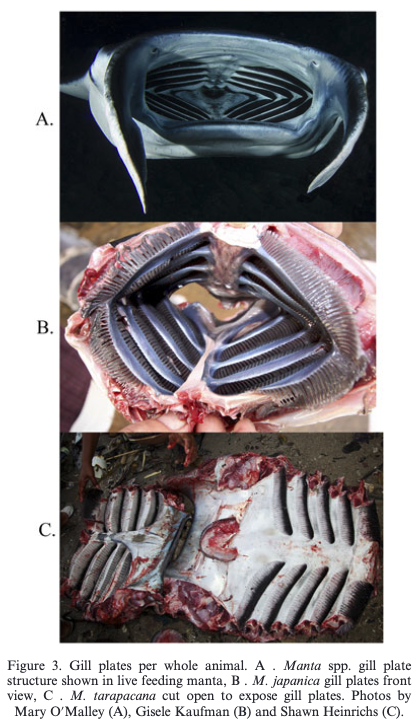Characterization of the trade in manta and devil ray gill plates in China and South-east Asia through trader surveys
June 2016
Mary p. O'Malley, Kathy A. Townsend, Paul Hilton, Shawn Heinrichs & Joshua D. Stewart
Keywords: Endangered Species • Sustainability • Fish • Fishing • Ocean


Summary: The trade in dried gill plates from manta and devil rays is a significant driver of fisheries and population declines. This study estimates the number and species of mobulids involved in this trade and investigates the consumers and suppliers. Guangzhou, China is the primary market, accounting for most of the dried gill plates, but the market declined due to conservation efforts. Hong Kong's sales, however, increased. Vendors promote gill plates for various health ailments in traditional Chinese medicine. To protect these vulnerable species, measures to restrict mobulid fisheries and trade are recommended alongside consumer demand reduction efforts.
Abstract
“1. Dried gill plates from manta and devil rays, some of the world's most biologically vulnerable fishes, have become a valued commodity in Asian dried-seafood and traditional Chinese medicine markets. This trade is a primary driver of fisheries, which have led to declines in many mobulid populations.
2. With no reliable trade statistics and scarce data on mobulid fisheries, this study estimates the number and species of mobulids required to supply this trade, and investigates the consumers and suppliers involved and drivers of demand. Following preliminary market research, 525 trader surveys were conducted in Hong Kong, Singapore, Macau, Taiwan, and southern China.
3. Guangzhou, China was identified as the centre of the trade accounting for 99% of total estimated market volume of 60.5 tons of dried gill plates in 2011, increasing to 120.5 tons by 2013. The estimated number of mobulids converted from tons of gill plates more than doubled over the period to 130 000, comprising 96% devil rays, Mobula japanica, Mobula thurstoni, and Mobula tarapacana, and 4% Manta spp. By 2015 the Guangzhou market had declined sharply, reportedly due to conservation campaigns and government policies. However Hong Kong's gill plate sales increased dramatically between 2011 and 2015.
4. China, Indonesia, Vietnam, Sri Lanka, and India were reported most frequently as gill plate sources.
5. Vendors recommend gill plates (trade name pengyusai) for ailments ranging from acne to cancer and as a general health tonic. While pengyusai is a new addition to traditional Chinese medicine literature and is rarely prescribed by traditional medicine practitioners, it is readily available over the counter and aggressively marketed by vendors.
6. Working in concert with consumer demand reduction efforts, increased measures to restrict mobulid fisheries and trade are recommended to prevent further population declines of these highly vulnerable species.”
Author Affiliations
WildAid
Manta Trust
School of Biological Sciences, Moreton Bay Research Station, The University of Queensland
Scripps Institution of Oceanography
Funded by
Save Our Species programme of the International Union for the Conservation of Nature
Global Environment Facility
World Bank

